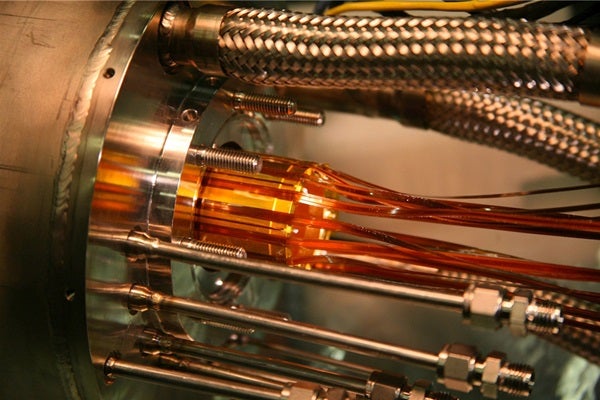“We’ve demonstrated that we can probe the internal structure of the antihydrogen atom, and we’re very excited about that,” said ALPHA collaboration spokesman Jeffrey Hangst. “We now know that it’s possible to design experiments to make detailed measurements of antiatoms.”
Today, we live in a universe that appears to be made entirely of matter, yet at the Big Bang, matter and antimatter would have existed in equal amounts. The mystery is that all the antimatter seems to have gone, leading to the conclusion that nature must have a slight preference for matter over antimatter. If antihydrogen atoms can be studied in detail, as ALPHA’s latest result suggests, they may provide a powerful tool for investigating this preference.
Hydrogen atoms consist of an electron orbiting a nucleus. By firing light at them, the atoms can be excited, with the electrons jumping to higher orbits and eventually relaxing back to their so-called ground state by emitting light. The frequency distribution of the light emitted forms a precisely measured spectrum that, in the matter world, is unique to hydrogen. Basic principles of physics say that antihydrogen should have an identical spectrum to hydrogen, and measuring this spectrum is the ultimate goal of the ALPHA collaboration.
“Hydrogen is the most abundant element in the universe, and we understand its structure extremely well,” said Hangst. “Now we can finally begin to coax the truth out of antihydrogen. Are they different? We can confidently say that time will tell.”
In the paper published March 7, ALPHA reports the first, albeit modest, measurement of the antihydrogen spectrum. In the ALPHA apparatus, antihydrogen atoms are trapped by a sophisticated arrangement of magnetic fields acting on the magnetic orientation of the antihydrogen atoms. By shining microwaves with a precisely tuned frequency on the antihydrogen atoms, the collaboration flips the antiatoms’ magnetic orientation, thereby liberating antihydrogen from the trap. When this happens, the antihydrogen meets ordinary matter and annihilates, leaving a characteristic pattern in particle detectors surrounding the trap. This measurement shows that it is possible to set up experiments in which the internal properties of antihydrogen atoms can be changed by shining microwaves on them. In the near future, ALPHA will work at improving the precision of the microwave measurements and undertake complementary measurements of the antihydrogen spectrum using lasers.










